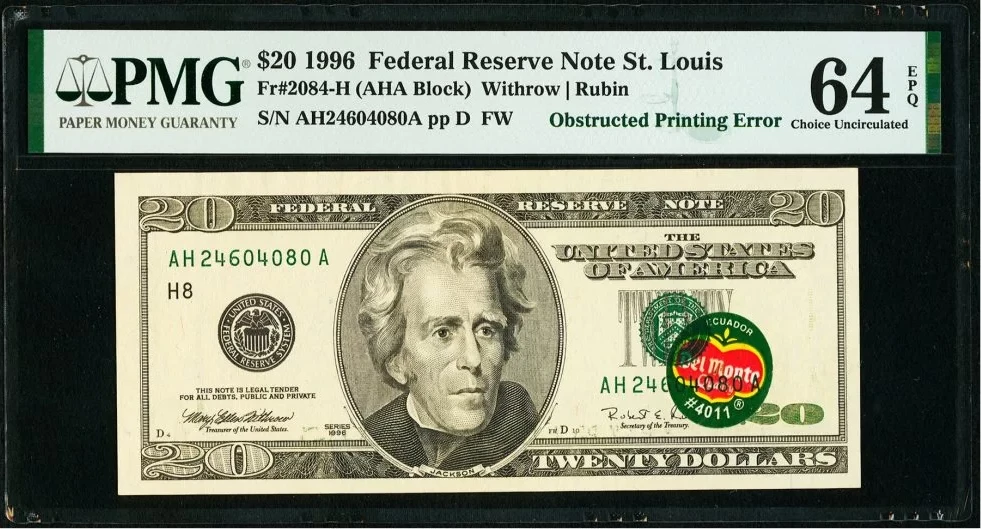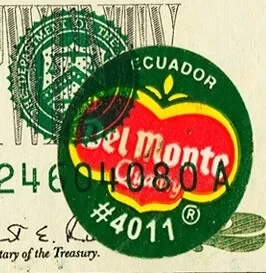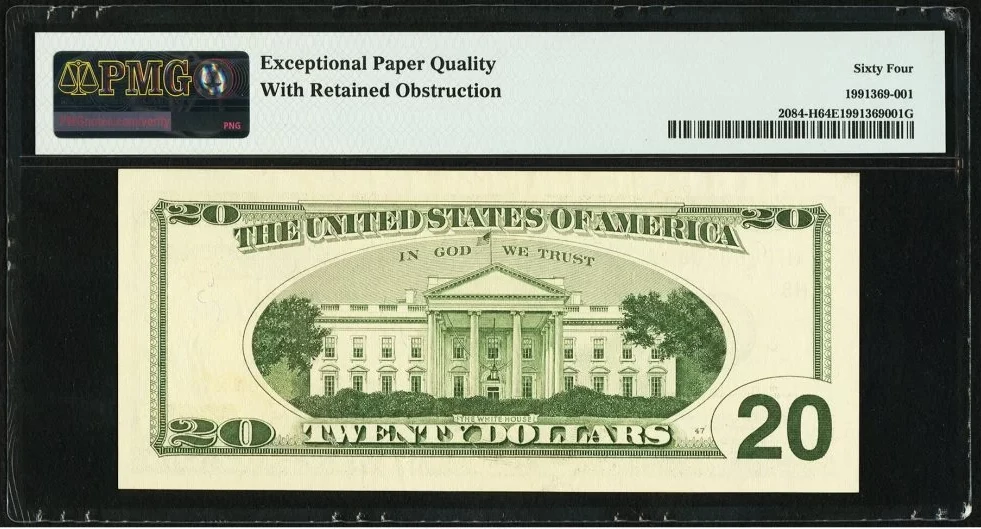Both in numismatics and in notaphily there are errors and there are ERRORS. Those errors in capital letters usually tend to be spectacular. And one of the most spectacular errors in US notes is the Del Monte Note, that has a banana label stuck to it.
I remained obsessed with it since I saw it for the first time, so, in order to quench my thirst of knowledge about it, I knew I absolutely had to conduct a little research into it. This article is the result of my fixation on why the Del Monte Note exists and how such a thing could happen.
This is the ‘Del Monte Note’
So this is the infamous banknote:

As you can see, it has a very strange particularity: a yellow, green and red banana label from the Del Monte brand stuck to it. And, on top of the banana label, there’s the serial number and the Treasury Department Seal, indicating that the banana label was stuck before the bill was fully printed.
The Del Monte Note is one of the most striking examples of what is know in the hobby as a “retained obstruction error”. It happens when a foreign object is somehow placed between the printing roller and the uncut banknote sheet while the latter is being printed.
These are very rare banknotes, as they are usually detected during quality control, and destroyed quite quickly. And, moreover, if they happen to end up in circulation, the foreign object typically falls off from the bill, leaving a white spot in an otherwise fully printed piece. So, finding an error bill in which the object is still there (that’s why we call it “retained”) is remarkably unusual.

The Del Monte Note is a banknote from the 1996 20 Dollar Series, manufactured from 1996 to 2004. It was printed in the United States Bureau of Engraving and Printing’s Fort Worth (Texas) facilities, as the little FW initials to the right of Andrew Jackson’s portrait indicate. As such, it is unquestionable legal tender.
The banknote is certified by the American company PMG, which decided that its conservation state was 64 in the Sheldon scale, which means it is in mint state, or, in other words, the banknote looks like new. Plus they marked it as EPQ, initials for “Extraordinary Paper Quality”, which implies that it hasn’t been manipulated in order to make it look like it’s better preserved than it originally was.
And how does a banana label end up there?
It’s very easy to describe how a banana label ends up in a banknote, but very hard for it to actually happen.
In the US, banknote printing requires 3 steps:
1- The back of the bill is printed on banknote paper (which is actually not paper, it’s a 75% cotton, 25% linen mix);
2- The front of the bill is printed;
3- The serial numbers and the Treasury Department Seal are printed.
Here’s a video of the process:
Once the printing process is over, the banknote sheet is inspected, and then cut into individual banknotes, which are inspected again before being packaged and sent to banking institutions. As I’m sure you can imagine, the inspection process is quite thorough, and it usually detects most of the errors that might have happened during printing and cutting. But most of the errors is not all of the errors: once in a blue moon, one goes undetected.
So, at some point between steps 2 and 3 of the printing process, an employee either placed or dropped the label on the still uncut banknote sheet. And, during those multiple inspection stages, no one noticed it.
But… was it on purpose, or an accident?
We don’t really know for sure. In fact, this is one of the great controversies around this bill.
Most experts, on the basis of the perfect location of the label on the note and it having gone undetected on so many inspections, think that it was placed there on purpose by a Bureau of Engraving and Printing employee, who might have wanted to play a joke for internal consumption that ended up getting out of hand.
A small number of people, however, thinks that it was an accident. Their main argument is that, when there is a fraudulent banknote printing or coin minting run, the main goal of the employee who caused it is to earn some dough with it by secretly extracting it from the facility and selling it to some private dealer. For instance, that is what happened in the 1980s in Spain, when an employee of the Spanish Mint illegally created gold and silver versions of regular circulating coins and sold them on the grey market. But this didn’t happen with this note.

Unfortunately, it’s quite possible that we will never know the truth about the Del Monte Note. But we do know what happened to it.
Once upon a time, there was an ATM
Just in case that, by itself, the Del Monte Note wasn’t strange enough, on top of everything, this is one of the very few occasions in which we can actually trace its complete chain of custody.
After being printed and leaving the BEP facilities in Fort Worth, the bill went through the procedures that the US Federal Reserve (the ‘Fed’) has set up to issue bills into circulation, since they are the responsible body for it. And the Fed has a regional branch in St. Louis, Missouri. As indicated by the “H8” that appears on the front of the Del Monte Note, under the serial number, that’s where the package containing it was sent to. From there, it was sent to some unknown commercial bank branch somewhere in one of the 7 states that the St. Louis Fed regional branch is responsible for, which placed it in their ATM.
One day, a young college student happened to go to that particular ATM to withdraw some money. When he paid attention to the bills the machine had given to him, he noticed something strange in one of them: a banana label. He immediately suspected that it had to be worth a ton.
So, that same year (some sources say it was 2003, others, 2004), the student put the Del Monte Note up for auction on eBay. And he had his suspicions confirmed: even though the piece wasn’t yet very well known in collector and banknote expert circles, it got 12 bids, taking it to a final price of 12,100$.
The winner was Daniel Wishnatsky, a banknote collector from Phoenix, Arizona, and a member of the Society of Paper Money Collectors. He thought that the banknote’s value could be as high as two or three times the price he paid for it. So he sent it to PCGS to be certified, getting a 63 in the Sheldon scale.
Wishnatsky owned the Del Monte Note until January 6, 2006. That day, it was sold in what is probably the most important numismatics event in the US, the FUN fair in Florida. It was auctioned off by Heritage Auctions, and it fetched a 25,300$ hammer price, thus validating Whisnatsky’s hunch.
It was bought by one Jackie Morales, the owner of an RV dealership in (very appropriately) a Fort Worth suburb called Cleburne. Morales, who saw the bill as more of an investment than a collector’s piece, advertised it like there was no tomorrow, with the goal of adding even more value to it through marketing. And, at some point, he sent it to PMG to be re-certified.
And Morales’ tactics were wildly successful. The last time the bill was sold in a public setting was January 22, 2021. It was planned to be auctioned off, once again, at the FUN fair that year, but it was cancelled due to COVID, with the sale moving online to the Heritage Auctions site. Still, that wasn’t an obstacle for the Del Monte Note to achieve its highest price yet: 396,000$.
Here’s a video of the moment (the hammer price was 340,000$, the 396,000$ figure comes from adding the auction house’s buyer’s fee):
Not bad for a banana label.

